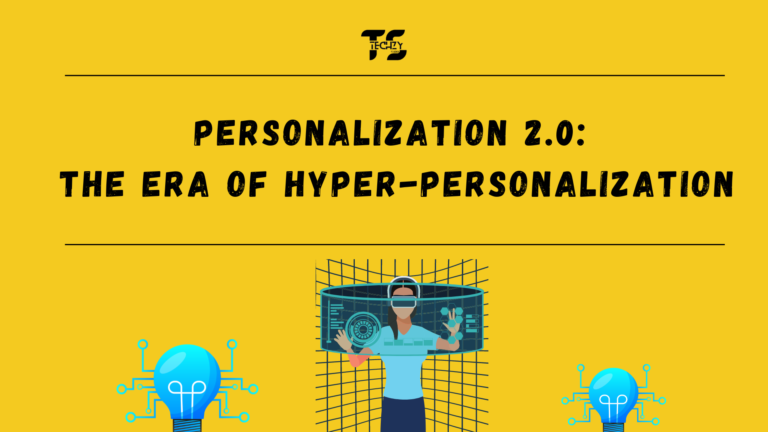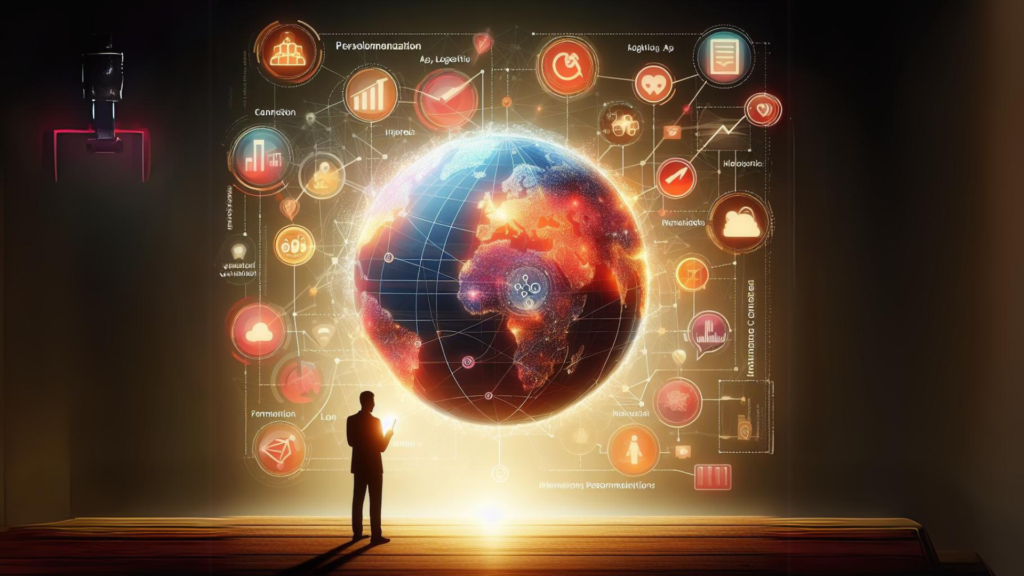Personalization 2.0: The Era of Hyper-Personalization
- Jay Prajapat
- January 13, 2024

INTRODUCTION: Personalization 2.0
In the ever-evolving landscape of technology and consumer expectations, personalization has emerged as a key driver of customer satisfaction and business success. From the early days of basic customization to the current era of advanced algorithms, we are now witnessing the dawn of Personalization 2.0 – the era of hyper-personalization. This paradigm shift is redefining the way businesses engage with their customers, offering a level of individualization that goes beyond anything we’ve seen before.
Defining Personalization 2.0 and Hyper-Personalization
Personalization 2.0 goes beyond basic customization by leveraging cutting-edge technologies like Artificial Intelligence (AI) and Machine Learning (ML). Hyper-personalization takes it a step further, considering real-time data and contextual information to provide tailor-made experiences.
In the realm of marketing and customer experience, these concepts are invaluable. They allow brands to move beyond a one-size-fits-all approach, creating individualized interactions that resonate with each customer on a personal level. Let’s explore why this shift is essential and highlight some brands leading the way.

The Evolution of Personalization
The evolution of personalization has transcended traditional boundaries, ushering in Hyper Personalization 2.0. This advanced phase leverages cutting-edge technologies like Artificial Intelligence (AI) and Machine Learning (ML) to refine user experiences. Unlike its predecessors, Hyper Personalization 2.0 delves deeper into individual preferences, utilizing real-time data analysis to predict and cater to evolving needs. It goes beyond mere content recommendations, customizing interactions across platforms seamlessly. However, as personalization reaches new heights, ethical considerations arise, demanding a delicate balance between delivering personalized experiences and respecting user privacy. Hyper Personalization 2.0 marks a transformative era, pushing the boundaries of tailored interactions while emphasizing the importance of responsible implementation.
Personalization in the digital realm began with simple touches, like adding a user’s name to emails or recommending products based on past purchases. Over time, companies started harnessing data to segment their audiences and deliver more targeted content. However, as technology advanced and data analytics became more sophisticated, the concept of hyper-personalization took shape.
Data: The Fuel of Hyper-Personalization
Hyper-personalization relies heavily on data – the raw material that powers algorithms and machine learning models. With the proliferation of connected devices and the increasing digitization of our lives, there is an unprecedented amount of data available. This data is the foundation upon which hyper-personalization is built, enabling businesses to understand their customers on a granular level.
In the era of digital transformation, data has emerged as the pivotal fuel driving hyper-personalization across various industries. As businesses harness the power of big data analytics and machine learning, they delve into vast pools of information to understand individual preferences, behaviors, and needs. This wealth of data serves as the foundation for tailoring products, services, and experiences to meet the unique demands of each customer.
From personalized recommendations on streaming platforms to targeted advertising and customized shopping experiences, data enables organizations to create a hyper-personalized landscape. The intricate analysis of user data not only enhances customer satisfaction but also cultivates brand loyalty by delivering content and solutions aligned with individual expectations. However, the ethical implications of data usage and the need for robust privacy measures have become critical considerations in this data-driven paradigm. Striking the right balance between personalization and privacy remains a challenge as society navigates the transformative potential of data in shaping the future of personalized interactions.
Artificial Intelligence and Machine Learning
Artificial Intelligence (AI) and Machine Learning (ML) have revolutionized the concept of hyper-personalization, tailoring user experiences with unprecedented precision. These technologies enable systems to analyze vast datasets, learning individual preferences, behaviors, and patterns. In the realm of hyper-personalization, AI and ML algorithms can predict user needs, delivering personalized content, recommendations, and services.
E-commerce platforms leverage AI to suggest products based on past purchases, while streaming services recommend movies or songs tailored to individual tastes. Hyper-personalization extends to marketing strategies, where AI analyzes user interactions to craft targeted campaigns. This dynamic duo enhances customer engagement, satisfaction, and loyalty by providing relevant and timely information.
However, ethical considerations and data privacy concerns arise as AI systems collect and process sensitive user information. Striking a balance between personalization and privacy is crucial to harness the full potential of AI and ML in creating seamless, personalized experiences that enhance user satisfaction without compromising individual rights.
Why It Matters:
In an era where consumers are inundated with information, standing out requires more than generic messaging. Hyper-personalization is a strategic imperative for brands looking to enhance customer satisfaction, loyalty, and ultimately, their bottom line.
Examples of Brands Doing it Well:
Netflix: The streaming giant analyzes viewing history, watch patterns, and user preferences to offer personalized content recommendations, keeping users engaged and subscribed.
Spotify: By curating playlists based on listening habits and preferences, Spotify delivers a unique music experience to each user, fostering a sense of connection and personalization.
Amazon: The e-commerce giant sets the standard for hyper-personalization with its dynamic product recommendations, personalized emails, and targeted advertising, creating a seamless and personalized shopping journey.
Benefits of Hyper-Personalization:
● Increased Customer Loyalty: Personalized experiences create emotional bonds, cultivating loyalty. Customers are more inclined to stay with a brand that understands and caters to their individual needs, fostering lasting connections.
● Enhanced Engagement and Conversion: Tailoring content and offerings to individual preferences elevates engagement levels. This heightened engagement, in turn, significantly increases conversion rates, transforming casual visitors into devoted customers, drawn in by the personalized experience.
● Improved Retention: A profound understanding of customer preferences facilitates proactive retention strategies. By addressing individual needs, businesses can reduce churn rates, extending customer lifetimes, and ultimately boosting overall customer lifetime value.
Challenges of Implementing Hyper-Personalization:
While the benefits are clear, implementing hyper-personalization comes with its own set of challenges.
● Data Privacy: The delicate balance between personalization and privacy demands meticulous management of customer data to establish and maintain trust. Respecting user privacy, securing data, and adhering to regulations are paramount to sustaining a positive customer relationship.
● Integration: Seamless hyper-personalization hinges on efficient data synchronization across diverse platforms and channels. The integration of information ensures a cohesive and unified customer experience, eliminating silos and enabling a comprehensive understanding of user preferences and behaviors.
● Scalability: As businesses expand, ensuring that personalization efforts scale effectively becomes a pivotal challenge. Balancing growth with personalized experiences demands robust systems and strategies to accommodate increasing data volumes and diverse customer interactions. Achieving scalability is vital for sustaining personalized services amid business expansion.
Best Practices for Achieving Hyper-Personalization:
● Utilize AI and ML: Harness the power of Artificial Intelligence (AI) and Machine Learning (ML) to analyze extensive datasets, forecast user behavior, and provide real-time personalized experiences. These advanced technologies enable businesses to adapt and respond dynamically to individual preferences, enhancing the overall customer experience.
● Omnichannel Data Integration: Foster a seamless customer journey by integrating data from diverse touchpoints. Achieving omnichannel data integration ensures a unified view of each customer, allowing businesses to tailor interactions consistently across various platforms for a cohesive and holistic personalized experience.
● Develop Customer Personas: Crafting detailed customer personas is instrumental in comprehending individual preferences. By creating accurate and insightful representations of different customer segments, businesses can tailor their personalization strategies more precisely, aligning offerings with the specific needs and expectations of each persona.
The Future of Hyper-Personalization:
As we stand on the precipice of technological advancement, the future of hyper-personalization promises to be both fascinating and transformative. Several key trends and developments provide a glimpse into what lies ahead for this cutting-edge approach to customer engagement.
1) Artificial Intelligence Evolution:
The evolution of Artificial Intelligence is at the forefront of the future of hyper-personalization. As AI technologies become more sophisticated, they will not only analyze historical data but also predict future behaviors with unprecedented accuracy. This will enable businesses to anticipate customer needs in real-time, providing personalized experiences that feel almost intuitive.
2) Integration of Augmented Reality (AR) and Virtual Reality (VR):
The integration of AR and VR into hyper-personalization strategies is on the horizon. Imagine a virtual shopping experience where customers can interact with products in a lifelike environment tailored to their preferences. This immersive approach has the potential to redefine online shopping, providing a level of personalization that transcends traditional boundaries.
3) Internet of Things (IoT) Integration:
The Internet of Things, with its network of interconnected devices, will play a pivotal role in the future of hyper-personalization. From smart homes adjusting environments based on individual preferences to wearable devices providing real-time health insights, the data generated by IoT will offer a goldmine for personalization strategies, ensuring a seamless integration of personalized experiences into everyday life.
4) Enhanced Privacy and Ethical Considerations:
As hyper-personalization continues to evolve, so will the focus on privacy and ethical considerations. Consumers are becoming increasingly aware of the value of their data, demanding transparency and control over how it is utilized. The future will see businesses investing in robust privacy measures and ethical frameworks to build and maintain trust.
5) Personalized Content Beyond Marketing:
While hyper-personalization has predominantly been associated with marketing, the future will witness its expansion into other realms. From personalized learning experiences in education to healthcare solutions tailored to individual health profiles, the applications of hyper-personalization will extend far beyond the realm of commerce.
Conclusion:
Personalization 2.0, the era of hyper-personalization, represents a seismic shift in the way businesses connect with their customers. Leveraging advanced technologies like AI and ML, companies can create deeply personalized experiences that go beyond mere customization. However, as we move forward, it is crucial for businesses to navigate the ethical considerations surrounding hyper-personalization and ensure that user privacy and trust are prioritized. As we step into this new era, the possibilities are vast, and the businesses that master hyper-personalization are likely to redefine the future of customer engagement.
1 thought on “Personalization 2.0: The Era of Hyper-Personalization”
Элвис Пресли, безусловно, один из наиболее влиятельных музыкантов в истории. Родившийся в 1935 году, он стал иконой рок-н-ролла благодаря своему харизматичному стилю и неповторимому голосу. Его лучшие песни, такие как “Can’t Help Falling in Love”, “Suspicious Minds” и “Jailhouse Rock”, стали классикой жанра и продолжают восхищать поклонников по всему миру. Пресли также известен своими выдающимися выступлениями и актёрским талантом, что сделало его легендой не только в музыке, но и в кинематографе. Его наследие остается живым и вдохновляет новые поколения артистов. Скачать музыку 2024 года и слушать онлайн бесплатно mp3.